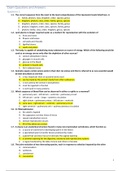Exam Questions and Answers
Questions 1
1.1. The correct sequence from the most to the least comprehensive of the taxonomic levels listed here, is
A. family, phylum, class, kingdom, order, species, genus
B. kingdom, phylum, class, order, family, genus, species
C. kingdom, phylum, order, class, species, family, genus
D. phylum, kingdom, order, class, species, family, genus
E. phylum, family, class, order, kingdom, genus, species
1.2. Land plants no longer required water as a medium for reproduction with the evolution of
A. fruits and roots
B. flowers and leaves
C. cell walls and rhizoids
D. lignified stems
E. seeds and pollen
1.3. The body is capable of catabolizing many substances as source of energy. Which of the following would be
used as an energy source only after the depletion of other sources?
A. calcium phosphate in bone
B. glycogen in muscle cells
C. glucose in the blood
D. protein in muscle cells
E. fat in adipose tissue
1.4. Animals require certain amino acids in their diet. An amino acid that is referred to as non-essential would
be best described as one that
A. is less important than an essential amino acid
B. can be made by the animal’s body from other substances
C. is not used by the animal in biosynthesis
D. must be ingested in the diet
E. is not found in many proteins
1.5. Which sequence of blood flow can be observed in either a reptile or a mammal?
A. pulmonary vein – left atrium – ventricle – pulmonary circuit
B. left atrium – aorta – lungs – systemic circulation
C. right atrium – pulmonary artery – left atrium – ventricle
D. vena cava – right atrium – ventricle – pulmonary circuit
E. right ventricle – pulmonary vein – pulmocutaneous circulation
1.6. In Chlamydomonas
A. the adult is haploid
B. the zygospore survives times of stress
C. sexual reproduction occurs
D. asexual reproduction occurs
E. All of the above are correct
1.7. A cloaca is an anatomical structure found in many non-mammalian vertebrates, which function as
A. a source of nutrients for developing sperm in the testes
B. a specialised sperm-transfer device produced by males
C. a gland that secretes mucus to lubricate the vaginal opening
D. a common opening for the digestive, excretory and reproductive systems
E. a region bordered by the labia minora and clitoris in females
1.8. The joint evolution of two interacting species, each in response to selection imposed by the other
A. commensalism
B. symbiosis
C. coexistence
D. coevolution
1
,1.9. The innermost layer of the cortex in plant roots, a cylinder one cell thick that forms the boundary
between the cortex and vascular cylinder
A. epidermis
B. endodermis
C. pericycle
D. stele
1.10. An anatomical structure found in many non-mammalian vertebrates which functions as a common
exit for digestive, excretory and reproductive systems
A. caecum
B. cloaca
C. anus
D. oviduct
1.11. The maintenance of internal stability and constancy in living systems
A. equilibrium
B. haemostasis
C. homeostasis
D. metastasis
1.12. A type of cell with membrane enclosed nucleus and organelles
A. prokaryotic
B. stem
C. eukaryotic
D. ribosomes
1.13. An ovule producing reproductive organ of a flower consisting of the stigma, style and ovary
A. pistil
B. stamen
C. ovule
D. anther
1.14. The scientific discipline concerned with the naming of organisms
A. systematics
B. cladistics
C. phylogeny
D. taxonomy
1.15. The part of a flower that develops into a fleshy fruit
A. stigma
B. style
C. ovary
D. ovule
1.16. The primary body cavity of most invertebrates, containing circulatory fluid
A. abdomen
B. coelom
C. hemocoel
D. haemolymph
1.17. A group of small, simple, green land-dwelling plants of which a few are aquatic
A. moss
B. algae
C. bryophytes
D. chlorophytes
1.18. A pollen tube contains how many haploid sperm nuclei
A. 0
B. 1
C. 2
D. 3
2
, 1.19. The association between sucker fish (Remora) and shark is
A. predation
B. parasitism
C. symbiosis
D. commensalism
1.20. Fertilization normally occurs in the
A. uterus
B. vagina
C. cervix
D. oviduct
1.21. Regeneration, the regrowth of lost body parts, normally follows
A. fragmentation
B. all types of asexual reproduction
C. all types of sexual reproduction
D. parthenogenesis
1.22. The circulatory fluid found in body cavities of most invertebrates
A. haemolysis
B. haemolymph
C. haemocoel
D. haemoglobin
1.23. A type of cell without membrane enclosed nucleus and organelles
A. prokaryotic
B. stem
C. eukaryotic
D. nucleoid
1.24. Arrange the following taxonomic categories in their hierarchical order from highest to lowest (left
to right). Genus, Family, Class, Order, Phylum
A. Phylum, Order, Class, Genus, Family
B. Class, Phylum, Order, Family, Genus
C. Order, Phylum, Class, Family, Genus
D. Phylum, Class, Order, Family, Genus
1.25. All members of which of the following groups have the greatest number of characteristics in
common?
A. class
B. order
C. family
D. genus
1.26. The characteristics of the plant kingdom include
A. photosynthetic, no alternation of generations, unicellular
B. heterotrophic, alternation of generations, chitin cell walls, multicellular
C. photosynthetic, multicellular, alternation of generations, cellulose cell walls
D. photosynthetic, no alternation of generations, cellulose cell walls, unicellular
1.27. Which class of animal has skin with fur or hair, feeds their young milk and maintains a constant
body temperature?
A. fish
B. birds
C. reptiles
D. mammals
1.28. When air temperature exceeds their body temperature, jackrabbits living in hot, arid lands will
A. bask in a sunny, exposed area
B. dilate the blood vessels in their large ears
C. constrict the blood vessels in their large ears
3





